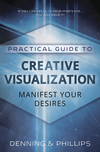Creative Visualization: A Basic Form of Magick

When magicians get philosophical, they often move to the discussion of the very nature of magick. What is magick? How is it different from anything else? The answer to the first question usually comes through definition. There are many definitions for magick, perhaps the simplest and most direct being "willed change." This brings up a bit of a problem (as noted by Crowley) as it would mean that every intentional act would be magickal. If you wanted to open a door and then opened a door, this very ordinary act could be described as magick.
Spiritually and philosophically, there are some advantages to such thinking. If you consider any willed act to be a magickal act then everything you consciously choose to do becomes an act of magick. This can result in you becoming more aware of everything you do, which may not only lead to more direction in your life, but also to more consideration for others.
But most people don't think of magick in those terms. Rather, they think of magick as a cause and effect relationship with an unknown middle step: Magickal Act —> Unknown Events —> Desired Result
We don't know what those middle events are. The will of God? Natural forces or laws? How can we dare to perform magick without knowing what goes on in the middle? But isn't this exactly what we do when we drive a car? We push down on the accelerator and the car moves. Most of us really don't care about pistons and smog valves. Even without knowing all that takes place within the engine I do know that it works. Likewise, experience has shown me that even if I don't know what takes place between the conclusion of a ritual and the manifestation of the work done in the ritual, the magick works.
A Basic Form of Magick
Going back to that original definition, it would seem that our wills play a vital function in magick. The most basic form of using will would exclude the need for tools or complex rituals. It would just require our minds.
There is a long history of this magickal technique. Some people have given it a variety of names in order to dodge the occult mystique of the subject. I've seen it called "positive imaging," "effective daydreaming," and even "wishcraft." In the occult world it is usually called creative visualization.
If creative visualization were simply a matter of thinking about something, everyone would be achieving their goals. Since that obviously is not occurring, the question we should ask ourselves is "What do I need to know about creative visualization so it will work for me?"
One of the things you need to know is that although it's called creative visualization, you don't need to actually see something in front of you or in your mind's eye. If you are simply sure that it is there, even if you can't see it, creative visualization will work.
To have success with creative visualization it is important to use all of your senses, and you should involve yourself in the visualization. What does the item you are visualizing sound like? How does it taste? What is its smell? The more you are involved, the more effective the magick.
Just spending five minutes in the morning and evening becoming totally involved and focused on your object of desire is really all it takes to make creative visualization work for you. Ten minutes a day can really change your life. For complete details on how to effectively use this form of magick, I recommend Denning & Phillips' book, Practical Guide to Creative Visualization. It gives several specific methods for practicing creative visualization and has a unique and useful format, making it exceptionally clear and easy to understand. Each chapter begins with a set of "Study Points," so you'll know what the important concepts in each chapter will be. Chapters conclude with a "Checkpoint" that reviews the important ideas of the chapter. This makes Practical Guide to Creative Visualization the best introduction and in-depth guide to this form of magick.

About Donald Michael Kraig
Related Products


is subject to certain Terms and Conditions